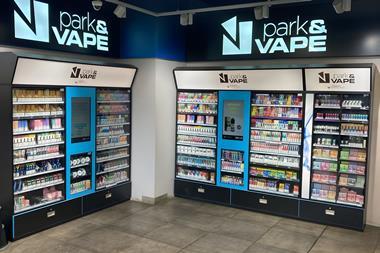Despite the government’s efforts to curb smoking in the UK, the tobacco category continues to thrive and maintain its position as the best-selling category in forecourts, responsible for almost one third of total forecourt shop sales.
The government has hit the tobacco industry with a ban on advertising, the introduction of larger health warnings on pack, restrictions on the advertising of brands at the point of sale and proposals to ban smoking in public places. Yet there are still 14.4 million smokers in the UK – 30.1% of the
adult population.
Forecourts have put in a particularly good performance in the past year, increasing their share of cigarette sales from 11.9% to 12.3%. Mike Laney, national account manager for forecourts at Imperial Tobacco, says forecourts are a dynamic sector: “These days, almost half of forecourt shoppers live within one mile of the store, and one in three uses the shop only rather than shop and petrol.”
When it comes to cigarette sales, premium-priced brands perform better in forecourts than in any other channel, excluding off-trade. Premium brands make up 42% of forecourt cigarette sales, compared to 29.2% in independent c-stores and 28.8% in multiple grocers.
Jeremy Blackburn, trade communications manager at Gallaher, says the premium bias is in line with the forecourt shopper profile. “The majority tend to be more affluent and brand-oriented than in other retail outlets,” he says. “Most people buying cigarettes in forecourts are doing so because it’s a handy location rather than because they are also buying petrol, so fast service and big brand availability are key. Price doesn’t play as big a part as in other channels.”
As such, Gallaher has developed the MaCS (Managed Category Solution) tobacco gantry, which is tailored to premium brands in a bid to focus on maintaining that sector in forecourts.
While mid-priced brands make up just 6.8% of cigarette sales in forecourts, compared to 12.7% in multiples and 9.3% in independent c-stores, low-priced brands perform above average in the forecourt sector – 25.5% of sales, compared to 18.3% in multiples and 22.8% in c-stores.
Imperial Tobacco believes the discount brand sector will continue to thrive to the point where it overtakes the premium sector. Mike Laney says: “Forecourts are more biased toward males and the younger age group than other sectors of the market but overall, the trend is for lower-priced brands growing share, and I think forecourts will eventually reflect market dynamics.”
Laney says it is important for forecourts to keep abreast of market trends: “Retailers want to keep value in the category but they must follow market trends. They should look at their planograms and how they’re facing brands to ensure they reflect consumer demand.
“And because tobacco is one of the most regional categories, it’s important for forecourts to establish whether they are a transient or local store. For example, if they’re on a holiday route and get an influx of people from certain areas, they must make sure they stock the right brands and review the range at certain times of the year. Our sales force can help with this.”
AVAILABILITY IS KEY
Imperial Tobacco’s research shows that if a smoker’s cigarette brand is out of stock, 30% of shoppers will buy another brand; 13% will buy a variant of the preferred brand; 3% will buy roll-your-own tobacco; and 53% will leave the store without making a purchase. With such a high percentage of shoppers willing to walk out empty- handed, ensuring availability at all times is vital.
“The outlet will not only miss out on tobacco purchases but other impulse purchases too,” warns Laney. “Also, if the customer calls three times and his or her brand is still out of stock, they will shop elsewhere, so individual forecourts need to look at their key trading times, when deliveries come in, and ensure they have enough stock available to replenish the unit.”
Laney says keeping the tobacco unit well-stocked, clean and tidy is also vital because the tobacco category can influence shoppers’ perception of the whole store. “Everyone sees the tobacco category because it’s behind the tills, so if they see a lot of gaps and it’s untidy, it reflects badly,” he says.
Meanwhile, HIM (Harris International Marketing) has been looking at the availability of 100 products – 12 of which were tobacco products – over the past eight months. “We’ve been visiting about 1,000 sites,” explains chief operating officer Tom Fender. “The perception has been that availability of tobacco products was at its worst on Friday and Saturday nights, but we have discovered that it is actually worse on Monday mornings.
“Gantries are being shopped out over the weekend. It’s not perfect at the weekends but it deteriorates to its worst on Mondays. If availability were better, retailers would increase their sales by 5-6% over the year.”
Fender says retailers need to look at when they are replenishing stock on a Monday. “It may be that it’s not until the shift change at about 3pm or 4pm, which will extend unavailability.”
Brand loyalty is very high in the tobacco category, says Fender. “There is a long tail of products but the challenge is for suppliers and retailers to work together to make sure retailers have sufficient stock of the key lines to get them through busy periods.”
ROLL YOUR OWN
The roll-your-own (RYO) sector is continuing to grow in popularity, and Mike Laney at Imperial Tobacco says this is because it has become more acceptable to adult smokers.
“We’re seeing more dualists – people who smoke both cigarettes and RYO – and more females are coming into the market,” he says. “Females aged 18-24 are realising the economy and control RYO offers as they decide how much tobacco they put in each cigarette.”
There are now around 1.5 million female dualists in the UK, and around half of all RYO smokers are aged 18-25. Golden Virginia dominates, with almost 60% of rolling tobacco sales in forecourts, according to RAL.
Within this category, Laney says forecourts have seen a trend toward bigger pack sizes.“We’ve having a lot of success in major forecourts with Golden Virginia 50g,” he says. “Traditionally, forecourts have just sold 12.5g and 25g packs but 50g makes up 13.5% of the market. Forecourts are at only 1.6% because the 50g pack size hasn’t been available to them. But we expect by 2007 that 50g will be up to 15% in forecourts. It’s a good opportunity for independents.”
ACCESSORIES
With the rise in popularity of roll-your-own tobacco comes a growth in smoking accessories such as cigarette papers and filters. And these present attractive margins for the retailer, up to around 50%.
“One in three RYO smokers uses filter tips, so this is a huge opportunity for the retail trade,” says Laney.
While Swedish Match dominates in the filter tips market, Rizla remains the number one seller in cigarette papers, with almost 93% of all rolling paper sales through forecourts (source: RAL). But that’s not stopping a flurry of activity in the sector.
Swedish Match, for example, recently introduced the Styx range of rolling papers, as well as Styx Combi, which comprises 50 papers and 50 slimline filters in one pocket-sized flip-top box. With a rrp of 59p, the Combi pack is available with green papers, which are currently the most popular variant of rolling papers.
Natalie Bridge, category manager at Swedish Match, says: “Younger RYO users tend to roll on the move, and with more of them using filter tips, we wanted to provide a product that would prove convenient.
“The Styx Combi pack fulfils all the practical demands and it is contemporary looking, which is key to this image-conscious market.”
The full Styx range includes two regular choices – Green Corner-cut and Red Standard – and two king size options – Blue Slim and Silver Ultra Fine. The regular papers retail at 22p, while the king size variants have a rrp of 50p for Blue and 70p for Silver. Rizla Regular Green makes up almost 47% of paper sales in forecourts but king-size variants are equally important.
NEW PRODUCTS
Despite the ban on advertising of tobacco products some tobacco companies are trying to launch brand extensions. First there was Silk Cut Slims from Gallaher, then in April this year, Philip Morris launched Marlboro Blend 28 to “meet the taste preferences of UK adult smokers”.
Marlboro Blend 28 balances high-quality Virginia, Burley and Oriental tobaccos, and comes in king size 20s and 10s packs, with a rrp of £4.98 and £2.52 respectively. The new product is being distributed in the UK by Imperial Tobacco.
Philip Morris is introducing a Marlboro Racing Edition to its Marlboro Reds King Size 20s. The limited edition packs feature racing car imagery and are available this month.
Mike Laney at Imperial Tobacco says that because launching new brands in a dark market makes it difficult to communicate to smokers, retailers should consider over-facing new products to create awareness of the new brand.






























No comments yet